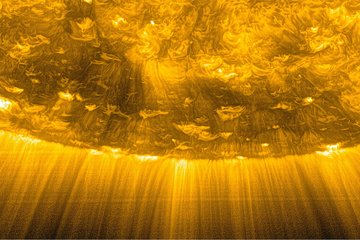All genres
21.
Journal Article
PMI: The Photospheric Magnetic Field Imager. Journal of Space Weather and Space Climate 10, 54 (2020)
22.
Journal Article
Power spectrum of turbulent convection in the solar photosphere. Astronomy and Astrophysics 644, A44 (2020)
23.
Journal Article
The Solar Orbiter Science Activity Plan: translating solar and heliospheric physics questions into action. Astronomy and Astrophysics 642, A3 (2020)
24.
Journal Article
Development and qualification of the Feed-Select Mechanism for the Polarimetric and Helioseismic Imager on-board Solar Orbiter. CEAS Space Journal 11 (4), pp. 497 - 505 (2019)
25.
Journal Article
A Tale of Two Emergences: SUNRISE II Observations of Emergence Sites in a Solar Active Region. Astrophysical Journal, Suppl. Ser. 229 (1), 3 (2017)
26.
Journal Article
Solar Coronal Loops Associated with Small-scale Mixed Polarity Surface Magnetic Fields. Astrophysical Journal, Suppl. Ser. 229, 4 (2017)
27.
Journal Article
Photospheric Response to an Ellerman Bomb-like Event-An Analogy of SUNRISE/IMaX Observations and MHD Simulations. Astrophysical Journal, Suppl. Ser. 229 (1), 5 (2017)
28.
Journal Article
Oscillations on Width and Intensity of Slender Ca ii H Fibrils from Sunrise/SuFI. Astrophysical Journal, Suppl. Ser. 229, 7 (2017)
29.
Journal Article
Morphological Properties of Slender Ca II H Fibrils Observed by Sunrise II. Astrophysical Journal, Suppl. Ser. 229, 6 (2017)
30.
Journal Article
Erratum: Morphological Properties of Slender Ca II H Fibrils Observed by SUNRISE II (vol 229, 6, 2017). Astrophysical Journal, Suppl. Ser. 230 (1), 11 (2017)
31.
Journal Article
The Maximum Entropy Limit of Small-scale Magnetic Field Fluctuations in the Quiet Sun. The Astrophysical Journal Supplement Series 233, 5 (2017)
32.
Journal Article
Slender Ca II H Fibrils Mapping Magnetic Fields in the Low Solar Chromosphere. Astrophysical Journal, Suppl. Ser. 229, 11 (2017)
33.
Journal Article
Kinematics of Magnetic Bright Features in the Solar Photosphere. Astrophysical Journal, Suppl. Ser. 229 (1), 8 (2017)
34.
Journal Article
Transverse Oscillations in Slender Ca II H Fibrils Observed with SUNRISE/SuFI. Astrophysical Journal, Suppl. Ser. 229 (1), 9 (2017)
35.
Journal Article
Moving Magnetic Features Around a Pore. Astrophysical Journal, Suppl. Ser. 229 (1), 13 (2017)
36.
Journal Article
Prospects of Solar Magnetometry-From Ground and in Space. Space Science Reviews 210 (1-4), pp. 397 - 426 (2017)
37.
Journal Article
Spectropolarimetric Evidence for a Siphon Flow along an Emerging Magnetic Flux Tube. Astrophysical Journal, Suppl. Ser. 229 (1), 15 (2017)
38.
Journal Article
A new MHD-assisted Stokes inversion technique. Astrophysical Journal, Suppl. Ser. 229, 16 (2017)
39.
Journal Article
The Second Flight of the SUNRISE Balloon-borne Solar Observatory: Overview of Instrument Updates, the Flight, the Data, and First Results. Astrophysical Journal, Suppl. Ser. 229 (1), 2 (2017)
40.
Journal Article
The Solar Ultraviolet Imaging Telescope on-board Aditya-L1. Current Science 113 (4), pp. 616 - 619 (2017)










